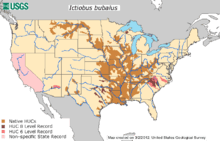Smallmouth buffalo
The smallmouth buffalo (Ictiobus bubalus, from the Greek for "bull-fish" and "buffalo") is a Catostomidae fish species native to the major tributaries and surrounding waters of the Mississippi River in the United States, as well as some other water systems where it has been introduced. It is a long-lived,[2] stocky fish like its relatives the bigmouth buffalo[3] (I. cyprinellus) and the black buffalo[3] (I. niger), although the smallmouth buffalo's mouth is located ventrally like other Catostomidae species, while the bigmouth buffalo's mouth is terminal and opens forward, and the smallmouth buffalo's eyes are significantly larger than those of the black buffalo. Despite being members of different scientific families, these three species superficially resemble the common carp (Cyprinus carpio), but an easy and notable difference is that all catostomids lack the characteristic barbels of carp.
| Smallmouth buffalo | |
|---|---|
| Scientific classification | |
| Kingdom: | Animalia |
| Phylum: | Chordata |
| Class: | Actinopterygii |
| Order: | Cypriniformes |
| Family: | Catostomidae |
| Genus: | Ictiobus |
| Species: | I. bubalus |
| Binomial name | |
| Ictiobus bubalus (Rafinesque, 1818) | |
 | |
| The distribution of I. bubalus in the United States | |
| Synonyms | |
| |
.jpeg)
Physical characteristics
The coloration of smallmouth buffalo ranges from shades of gray to brown and coppery green dorsally and pale yellow to white ventrally. Fin colors match the portion of the body where they attach and are generally darker towards the tips. They are characteristically stocky, having a hump that rises up from the operculum. Pectoral fins protrude ventrally like the anal fins, the caudal fin has even lobes, and the dorsal fin protrudes from the top of the hump to a blunt point, then shortens and runs the remaining length of the body to the base of the tail. Typical adults reach a length around 40–60 cm (16–24 in) with some specimens reaching as much as 90 cm (35 in).
Habitat
The smallmouth buffalo is a hardy fish that frequents clear, moderate to fast-moving streams, but has been occasionally known in some lakes and ponds. If prefers waters with dense aquatic vegetation and a silty bottom. It has a high tolerance for hard water and can survive in waters with pH ranges of 6.5–8.5.
Diet
The smallmouth buffalo's diet is primarily that of a detritivore, using its ventral sucker mouth to pick up vegetation and other organic matter from the bottom of its habitat, often scraping algae off of rocks. It is also quite the invertivore, consuming zooplankton, insect larvae, mollusk larvae, and small crustaceans.
Life history
Spawning usually takes place in spring and summer, with more specific times depending on the location of the population. Migration is negligible. Spawning often occurs in shallower sections of streams where the egg can adhere to vegetation and gravel to keep from flowing away. Each female can lay tens of thousands to hundreds of thousands of eggs at a time depending on her size, and no parental care is applied and the eggs hatch in one to two weeks. The young hide in aquatic vegetation to avoid predators. The lifespan of a smallmouth buffalo is not well known because of limited study on their otoliths and a reliance instead on other structures (e.g. scales, fin rays, gill plates) that are inadequate for age analysis.[4] However, a 2019 study took an initial look at their otoliths (earstones) from a commercially-harvested population in the middle Mississippi River drainage and found that even with harvest, about half of the sample was 20 years or older, with the oldest being 39 years of age.[2] Thus the potential lifespan of smallmouth buffalo is likely much older than 40 years, and awaits further investigation. The onset of sexual maturity for smallmouth buffalo varies by population but is typically 4–5 years for males and around 6 years for females.
Relationship with humans
Although historically and derogatorily considered by many to be a rough fish, smallmouth buffalo are native to North American ecosystems, are the most common commercially sold freshwater fish in the United States, are sought after by traditional anglers,[5] and they are rapidly becoming a new sportfish as modernized night bowfishing has become increasingly popular since 2010 - a sport that targets this species among others.[3] Thus, harvest management of this species (for sustainability) is in urgent need of reassessment as essentially no agency is tracking the ecological impact of modernized bowfishing, and there are virtually no limits on harvest. The species is highly valued by some as a human food source and the fish meal is common in animal feed. They are relatively quick and easy to raise in commercial farm ponds. Anglers seeking to hook a smallmouth buffalo have found success with doughballs and corn on hooks. The IGFA world record for Smallmouth Buffalo stands at 82lb 3oz taken from Lake Athens in Texas in 1993.[6]
References
- NatureServe (2013). "Ictiobus bubalus". IUCN Red List of Threatened Species. 2013: e.T191239A18236812. doi:10.2305/IUCN.UK.2013-1.RLTS.T191239A18236812.en.
- Love, Seth A.; Tripp, Sara J.; Phelps, Quinton E. (July 2019). "Age and Growth of Middle Mississippi River Smallmouth Buffalo". The American Midland Naturalist. 182 (1): 118–123. doi:10.1674/0003-0031-182.1.118. ISSN 0003-0031.
- Lackmann, Alec R.; Andrews, Allen H.; Butler, Malcolm G.; Bielak-Lackmann, Ewelina S.; Clark, Mark E. (2019-05-23). "Bigmouth Buffalo Ictiobus cyprinellus sets freshwater teleost record as improved age analysis reveals centenarian longevity". Communications Biology. 2 (1): 1–14. doi:10.1038/s42003-019-0452-0. ISSN 2399-3642.
- Campana, S. E. (2001). "Accuracy, precision and quality control in age determination, including a review of the use and abuse of age validation methods". Journal of Fish Biology. 59 (2): 197–242. doi:10.1111/j.1095-8649.2001.tb00127.x. ISSN 1095-8649.
- "Fishing for Buffalo". University of Minnesota Press. Retrieved 2020-06-14.
- "Buffalo, smallmouth". igfa.org. International Game Fish Association. Retrieved 17 May 2019.
- "Ohio Boating Accident Data Archive". Dnr.state.oh.us. Retrieved 2017-02-26.
- "Smallmouth Buffalo (Ictiobus bubalus)". Tpwd.state.tx.us. Retrieved 2017-02-26.
- "Smallmouth Buffalo (Ictiobus bubalus) - FactSheet". Nas.er.usgs.gov. Retrieved 2017-02-26.
External links


